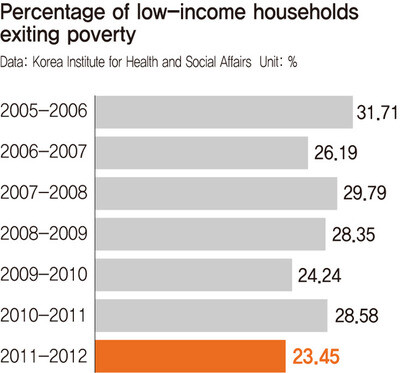hankyoreh
Links to other country sites 다른 나라 사이트 링크
Report: fewer low-income households breaking out of poverty

By Son Jun-hyun, senior staff writer
The “have-nots” are finding it more difficult to escape poverty with each passing year, research findings show.
Statistics suggest that class mobility is becoming a distant dream, with poverty becoming entrenched as irregular workers lack full-time work opportunities and low-income families find it impossible to escape the debt trap.
The Korea Institute for Health and Social Affairs (KIHASA) released a report on Jan. 7 from an eight-year Korea Welfare Panel study of income for 5,015 households between 2005 and 2012. The findings showed the poverty exit rate for ordinary income (regular and predictable sources such as wages, rental fees, and interest earnings) dropping by more than eight percent from 31.7% to 23.4% over that period.
According to the report, one out of every three low-income households in 2005 saw its finances improve enough to qualify as middle or upper class the following year. In 2012, just one in four households that had been poor the year before had exited poverty.
The poverty exit rate is the percentage of households that qualified as low income (less than 50% of the median, or the middle value when all incomes re considered) at a particular time that subsequently moved into the middle class (50-150% of the median income) or upper class (more than 150%).
For the years 2005-06, 2.53% of low-income households made the leap to the upper income level in the space of one year. For 2008-09, the rate was down to 1.43%; for 2011-12, it was just 0.48%. The numbers show that the chances of a quick rags-to-riches story are dissipating.
The rate of advancement from middle to upper income also dropped from 13.38% in 2005-06 to 10.95% in 2011-12.
In addition to the dimmer prospects for exiting poverty, the study also found the percentage of households escaping debt to be dropping each year. In eight years, the rate of families escaping debt fell by eleven percent, from 66.08% in 2005-06 to 56.58% in 2008-09 and 54.46% in 2011-12.
The entrenchment of poverty was accompanied by stratification in forms of employment. In 2011, just 9.9% of temporary or day laborers were hired to permanent positions within a one-year period. The rate was down sharply from the 12.78% recorded in 2009-10 and the 15.05% in 2010-11. The percentage of people who continued to hold temporary and day labor positions after one year rose from 83.74% in 2009-10 to 86.68% in 2011-12.
“What we‘re finding is that the likelihood of low-income households remaining low-income continues to rise, while the chances of their escaping the low-income level to become middle or upper income is falling,” KIHASA said in its report.
“We need to help poor families escape poverty by creating better job opportunities and welfare policies,” the institute recommended.
Please direct questions or comments to [english@hani.co.kr]

Editorial・opinion
![[Column] Has Korea, too, crossed the Rubicon on China? [Column] Has Korea, too, crossed the Rubicon on China?](https://flexible.img.hani.co.kr/flexible/normal/500/300/imgdb/original/2024/0419/9317135153409185.jpg) [Column] Has Korea, too, crossed the Rubicon on China?
[Column] Has Korea, too, crossed the Rubicon on China?![[Correspondent’s column] In Japan’s alliance with US, echoes of its past alliances with UK [Correspondent’s column] In Japan’s alliance with US, echoes of its past alliances with UK](https://flexible.img.hani.co.kr/flexible/normal/500/300/imgdb/original/2024/0419/2317135166563519.jpg) [Correspondent’s column] In Japan’s alliance with US, echoes of its past alliances with UK
[Correspondent’s column] In Japan’s alliance with US, echoes of its past alliances with UK- [Editorial] Does Yoon think the Korean public is wrong?
- [Editorial] As it bolsters its alliance with US, Japan must be accountable for past
- [Guest essay] Amending the Constitution is Yoon’s key to leaving office in public’s good graces
- [Editorial] 10 years on, lessons of Sewol tragedy must never be forgotten
- [Column] A death blow to Korea’s prosecutor politics
- [Correspondent’s column] The US and the end of Japanese pacifism
- [Guest essay] How Korea turned its trainee doctors into monsters
- [Guest essay] As someone who helped forge Seoul-Moscow ties, their status today troubles me
Most viewed articles
- 1[Column] The clock is ticking for Korea’s first lady
- 2Hong Se-hwa, voice for tolerance whose memoir of exile touched a chord, dies at 76
- 3After 2 months of delayed, denied medical care, Koreans worry worst may be yet to come
- 4[Column] Has Korea, too, crossed the Rubicon on China?
- 5[Correspondent’s column] In Japan’s alliance with US, echoes of its past alliances with UK
- 6US overtakes China as Korea’s top export market, prompting trade sanction jitters
- 7Samsung barricades office as unionized workers strike for better conditions
- 8All eyes on Xiaomi after it pulls off EV that Apple couldn’t
- 9More South Koreans, particularly the young, are leaving their religions
- 10John Linton, descendant of US missionaries and naturalized Korean citizen, to lead PPP’s reform effo